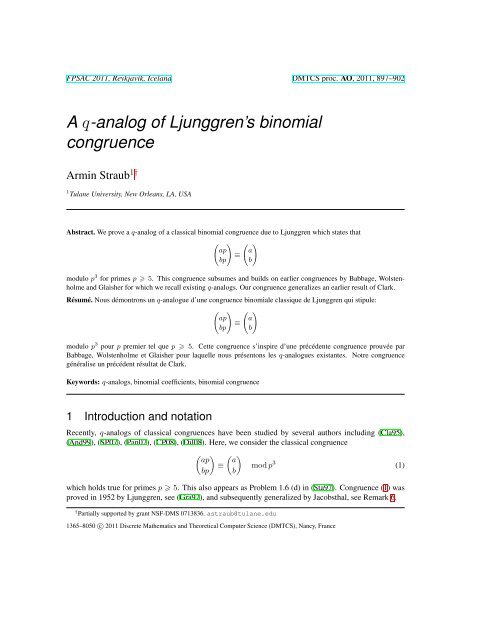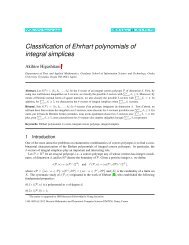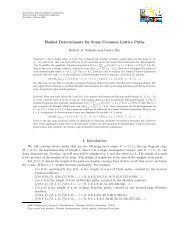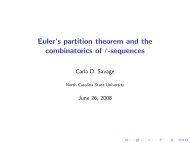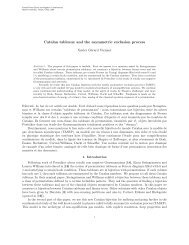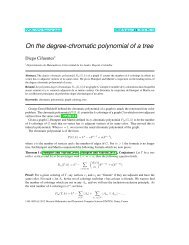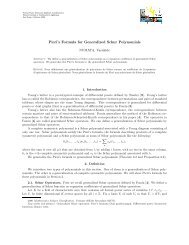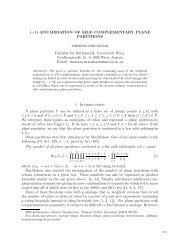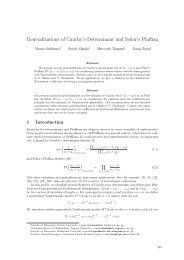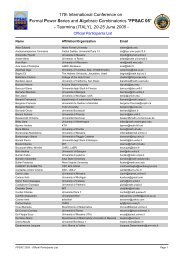A q-analog of Ljunggren's binomial congruence
A q-analog of Ljunggren's binomial congruence
A q-analog of Ljunggren's binomial congruence
You also want an ePaper? Increase the reach of your titles
YUMPU automatically turns print PDFs into web optimized ePapers that Google loves.
FPSAC 2011, Reykjavík, Iceland DMTCS proc. AO, 2011, 897–902A q-<strong>analog</strong> <strong>of</strong> Ljunggren’s <strong>binomial</strong><strong>congruence</strong>Armin Straub 1†1 Tulane University, New Orleans, LA, USAAbstract. We prove a q-<strong>analog</strong> <strong>of</strong> a classical <strong>binomial</strong> <strong>congruence</strong> due to Ljunggren which states that!apbp≡!abmodulo p 3 for primes p 5. This <strong>congruence</strong> subsumes and builds on earlier <strong>congruence</strong>s by Babbage, Wolstenholmeand Glaisher for which we recall existing q-<strong>analog</strong>s. Our <strong>congruence</strong> generalizes an earlier result <strong>of</strong> Clark.Résumé. Nous démontrons un q-<strong>analog</strong>ue d’une <strong>congruence</strong> <strong>binomial</strong>e classique de Ljunggren qui stipule:!apbp≡!abmodulo p 3 pour p premier tel que p 5. Cette <strong>congruence</strong> s’inspire d’une précédente <strong>congruence</strong> prouvée parBabbage, Wolstenholme et Glaisher pour laquelle nous présentons les q-<strong>analog</strong>ues existantes. Notre <strong>congruence</strong>généralise un précédent résultat de Clark.Keywords: q-<strong>analog</strong>s, <strong>binomial</strong> coefficients, <strong>binomial</strong> <strong>congruence</strong>1 Introduction and notationRecently, q-<strong>analog</strong>s <strong>of</strong> classical <strong>congruence</strong>s have been studied by several authors including (Cla95),(And99), (SP07), (Pan07), (CP08), (Dil08). Here, we consider the classical <strong>congruence</strong>( ) ( ap a≡ mod pbp b)3 (1)which holds true for primes p 5. This also appears as Problem 1.6 (d) in (Sta97). Congruence (1) wasproved in 1952 by Ljunggren, see (Gra97), and subsequently generalized by Jacobsthal, see Remark 6.† Partially supported by grant NSF-DMS 0713836. astraub@tulane.edu1365–8050 c○ 2011 Discrete Mathematics and Theoretical Computer Science (DMTCS), Nancy, France
898 Armin StraubLet [n] q := 1 + q + . . . q n−1 , [n] q ! := [n] q [n − 1] q · · · [1] q and( n [n] q !:=k)[k] q ![n − k] q !qdenote the usual q-<strong>analog</strong>s <strong>of</strong> numbers, factorials and <strong>binomial</strong> coefficients respectively. Observe that[n] 1= n so that in the case q = 1 we recover the usual factorials and <strong>binomial</strong> coefficients as well.Also, recall that the q-<strong>binomial</strong> coefficients are polynomials in q with nonnegative integer coefficients.An introduction to these q-<strong>analog</strong>s can be found in (Sta97).We establish the following q-<strong>analog</strong> <strong>of</strong> (1):Theorem 1 For primes p 5 and nonnegative integers a, b,( ) ( ( )( ) ap a a b + 1 p≡bp b)− 1b + 1 2 12 (qp − 1) 2 mod [p] 3 q . (2)qq p2 −The <strong>congruence</strong> (2) and similar ones to follow are to be understood over the ring <strong>of</strong> polynomials in q withinteger coefficients. We remark that p 2 − 1 is divisible by 12 for all primes p 5.Observe that (2) is indeed a q-<strong>analog</strong> <strong>of</strong> (1): as q → 1 we recover (1).Example 2 Choosing p = 13, a = 2, and b = 1, we have( ) 26= 1 + q 169 − 14(q 13 − 1) 2 + (1 + q + . . . + q 12 ) 3 f(q)13qwhere f(q) = 14 − 41q + 41q 2 − . . . + q 132 is an irreducible polynomial with integer coefficients. Uponsetting q = 1, we obtain ( 2613)≡ 2 modulo 13 3 .Since our treatment very much parallels the classical case, we give a brief history <strong>of</strong> the <strong>congruence</strong> (1)in the next section before turning to the pro<strong>of</strong> <strong>of</strong> Theorem 1.2 A bit <strong>of</strong> historyA classical result <strong>of</strong> Wilson states that (n − 1)! + 1 is divisible by n if and only if n is a prime number.“In attempting to discover some <strong>analog</strong>ous expression which should be divisible by n 2 , whenever n is aprime, but not divisible if n is a composite number”, (Bab19), Babbage is led to the <strong>congruence</strong>( ) 2p − 1≡ 1 mod p 2 (3)p − 1for primes p 3. In 1862 Wolstenholme, (Wol62), discovered (3) to hold modulo p 3 , “for several cases,in testing numerically a result <strong>of</strong> certain investigations, and after some trouble succeeded in proving it tohold universally” for p 5. To this end, he proves the fractional <strong>congruence</strong>s∑p−1i=1∑p−1i=11i ≡ 0 mod p2 , (4)1≡ 0 mod p (5)i2
A q-<strong>analog</strong> <strong>of</strong> Ljunggren’s <strong>binomial</strong> <strong>congruence</strong> 899for primes p 5. Using (4) and (5) he then extends Babbage’s <strong>congruence</strong> (3) to hold modulo p 3 :( ) 2p − 1≡ 1 mod p 3 (6)p − 1for all primes p 5. Note that (6) can be rewritten as ( )2pp ≡ 2 modulo p 3 . The further generalization <strong>of</strong>(6) to (1), according to (Gra97), was found by Ljunggren in 1952. The case b = 1 <strong>of</strong> (1) was obtained byGlaisher, (Gla00), in 1900.In fact, Wolstenholme’s <strong>congruence</strong> (6) is central to the further generalization (1). This is just as truewhen considering the q-<strong>analog</strong>s <strong>of</strong> these <strong>congruence</strong>s as we will see here in Lemma 5.A q-<strong>analog</strong> <strong>of</strong> the <strong>congruence</strong> <strong>of</strong> Babbage has been found by Clark (Cla95) who proved that( ) ( ap a≡ mod [p]bpqb)2 q . (7)q p2We generalize this <strong>congruence</strong> to obtain the q-<strong>analog</strong> (2) <strong>of</strong> Ljunggren’s <strong>congruence</strong> (1). A result similarto (7) has also been given by Andrews in (And99).Our pro<strong>of</strong> <strong>of</strong> the q-<strong>analog</strong> proceeds very closely to the history just outlined. Besides the q-<strong>analog</strong> (7)<strong>of</strong> Babbage’s <strong>congruence</strong> (3) we will employ q-<strong>analog</strong>s <strong>of</strong> Wolstenholme’s harmonic <strong>congruence</strong>s (4) and(5) which were recently supplied by Shi and Pan, (SP07):Theorem 3 For primes p 5,as well as∑p−1i=11≡ − p − 1[i] q 2 (q − 1) + p2 − 124 (q − 1)2 [p] q mod [p] 2 q(8)∑p−1i=11[i] 2 q≡ −This generalizes an earlier result (And99) <strong>of</strong> Andrews.3 A q-<strong>analog</strong> <strong>of</strong> Ljunggren’s <strong>congruence</strong>(p − 1)(p − 5)(q − 1) 2 mod [p]12q. (9)In the classical case, the typical pro<strong>of</strong> <strong>of</strong> Ljunggren’s <strong>congruence</strong> (1) starts with the Chu-Vandermondeidentity which has the following well-known q-<strong>analog</strong>:Theorem 4( ) m + n= ∑ kq j( mj)q( ) nq j(n−k+j) .k − jqWe are now in a position to prove the q-<strong>analog</strong> <strong>of</strong> (1).Pro<strong>of</strong> <strong>of</strong> Theorem 1: As in (Cla95) we start with the identity( ) ap ∑( ) ( ) ( )p p p=· · ·bpqc 1 qc 2 qc ac 1+...+c a=bpq p P 1ia (i−1)c i −P 1i
900 Armin Straubwhich follows inductively from the q-<strong>analog</strong> <strong>of</strong> the Chu-Vandermonde identity given in Theorem 4. Thesummands which are not divisible by [p] 2 q correspond to the c i taking only the values 0 and p. Since eachsuch summand is determined by the indices 1 j 1 < j 2 < . . . < j b a for which c i = p, the totalcontribution <strong>of</strong> these terms is∑1j 1
A q-<strong>analog</strong> <strong>of</strong> Ljunggren’s <strong>binomial</strong> <strong>congruence</strong> 901Pro<strong>of</strong>: Using that [an] q= [a] q n [n] qand [n + m] q= [n] q+ q n [m] qwe compute( 2pp)q= [2p] q [2p − 1] q · · · [p + 1] q[p] q[p − 1] q · · · [1] q= [2] q p[p − 1] q!p−1∏which modulo [p] 3 q reduces to (note that [p − 1] q ! is relatively prime to [p]3 q )⎛[2] q p⎝q (p−1)p + q (p−2)p1i
902 Armin StraubAcknowledgementsMost parts <strong>of</strong> this paper have been written during a visit <strong>of</strong> the author at Grinnell College. The authorwishes to thank Marc Chamberland for his encouraging and helpful support. Partial support <strong>of</strong> grantNSF-DMS 0713836 is also thankfully acknowledged.References[And99] George E. Andrews. q-<strong>analog</strong>s <strong>of</strong> the <strong>binomial</strong> coefficient <strong>congruence</strong>s <strong>of</strong> Babbage, Wolstenholmeand Glaisher. Discrete Math., 204(1):15–25, 1999.[Bab19] Charles Babbage. Demonstration <strong>of</strong> a theorem relating to prime numbers. Edinburgh PhilosophicalJ., 1:46–49, 1819.[Cla95] W. Edwin Clark. q-<strong>analog</strong>ue <strong>of</strong> a <strong>binomial</strong> coefficient <strong>congruence</strong>. Internat. J. Math. and Math.Sci., 18(1):197–200, 1995.[CP08] Robin Chapman and Hao Pan. q-<strong>analog</strong>ues <strong>of</strong> Wilson’s theorem. Int. J. Number Theory,4(4):539–547, 2008.[Dil08] Karl Dilcher. Determinant expressions for q-harmonic <strong>congruence</strong>s and degenerate Bernoullinumbers. Electron. J. Combin., 15(1), 2008.[Gla00] James W. L. Glaisher. Residues <strong>of</strong> <strong>binomial</strong>-theorem coefficients with respect to p 3 . Quart. J.Math., Oxford Ser., 31:110–124, 1900.[Gra97] Andrew Granville. Arithmetic properties <strong>of</strong> <strong>binomial</strong> coefficients I: Binomial coefficients moduloprime powers. CMS Conf. Proc., 20:253–275, 1997.[Pan07] Hao Pan. A q-<strong>analog</strong>ue <strong>of</strong> Lehmer’s <strong>congruence</strong>. Acta Arith., 128(4):303–318, 2007.[SP07] Ling-Ling Shi and Hao Pan. A q-<strong>analog</strong>ue <strong>of</strong> Wolstenholme’s harmonic series <strong>congruence</strong>.Amer. Math. Monthly, 114(6):529–531, 2007.[Sta97] Richard P. Stanley. Enumerative Combinatorics, Volume 1. Cambridge University Press, 1997.[Wol62] Joseph Wolstenholme. On certain properties <strong>of</strong> prime numbers. Quart. J. Math., Oxford Ser.,5:35–39, 1862.


